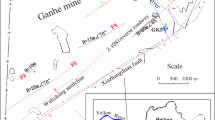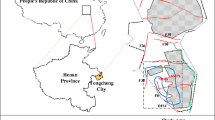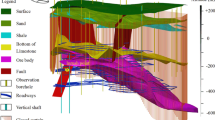Abstract
In 2010, a water inrush accident through a fault with a high flow rate occurred at Tianzhuang coal mine in **ing, Shandong Province, China, which was subject to the fault excavation. Grouting is an important treatment method before and after water inrush accidents. In this paper, the evolution of this water inrush accident is studied, and the effective treatment method is presented. The obtained results indicate that groundwater from Ordovician limestone aquifer 28.5 m below the floor flowed into the roadway through the fault zone. Results also show that this water inrush through the fault zone can be divided into a flow rate steady increase phase, a rapidly increase phase, a decrease phase, and a steady phase. The first two phases resulted from permeability increase of the fault, which was caused by seepage failure, and water level of the aquifer led to last two phases. Additionally, grouting using the ground borehole successfully controlled this water inrush accident, and it is proven to be a valid method.









Similar content being viewed by others
References
Babiker M, Gudmundsson A (2004) The effects of dykes and faults on groundwater flow in an arid land: the red sea hills, Sudan. J Hydrol 297:256–273
Caine JS, Evans JP, Foster CB (1996) Fault zone architecture and permeability structure. Geology 24(11):1025–1028
Huang Z, Jiang ZQ, Qian ZW et al (2014) Analytical and experimental study of water seepage propagation behavior in the fault. Acta Geodyn Geomater 11:361–370
Huang Z, Jiang ZQ, Tang X, Wu XS et al (2016) In situ measurement of hydraulic properties of the fractured zone of coal mines. Rock Mech Rock Eng 49:1–7
Johnsen Ø, Chevalier C, Lindner A et al (2008) Decompaction and fluidization of a saturated and confined granular medium by injection of a viscous liquid or a gas. Physical Rev E Stat Nonlinear Soft Matter Phys 78:051302
Li T, Mei T, Sun X, Lv Y et al (2013) A study on a water-inrush incident at Laohutai coalmine. Int J Rock Mech Min 59:151–159
Ma D, Rezania M, Yu HS et al (2017) Variations of hydraulic properties of granular sandstones during water inrush: effect of small particle migration. Eng Geol 217:61–70
Miller FP, Vandome AF, Mcbrewster J (1945) Darcy–Weisbach equation. Alphascript Publishing
Mukai A, Fujimori K (2007) Secular change of permeability in the fracture zone near the Nojima fault estimated using strain changes due to water injection experiments. Tectonophysics 443:193–199
Niebling M, Toussaint R, Flekkøy EG et al (2012) Dynamic aero fracture of dense granular packings. Phys Rev E Am Phys Soc 86:061315
Nikuradse J (1932) Laws of turbulent flow in smooth pipes. Regularity of Turbulent Flow in Smooth Pipes
Qiao W, Hu G, Li WP (2013) Experimental study on the conversion from seepage to flow of water inrush aroused by fault activation. J Min Saf Eng 30:30–37
Sui W, Liu J, Yang S, Chen Z et al (2011) Hydrogeological analysis and salvage of a deep coalmine after a groundwater inrush. Environ Earth Sci 62:735–749
Wu Q, Zhu B, Liu S (2011) Flow-solid coupling simulation method analysis and time identification of lagging water-inrush near mine fault belt. Chin J Rock Mech Eng 30(1):93–104
Zhang J (2005) Investigations of water inrushes from aquifers under coal seams. Int J Rock Mech Min 42:350–360
Zhang R, Jiang Z, Zhou H, Yang C, **ao S (2014) Groundwater outbursts from faults above a confined aquifer in the coal mining. Nat Hazards 71:1861–1872
Acknowledgements
This study was supported through funding from the National Natural Science Foundation of China (Grant No. 41602299 and 41702326) and the State Basic Research and Development Program of China (Grant No. 2013CB036003).
Author information
Authors and Affiliations
Corresponding author
Additional information
Highlights
• An underground water inrush accident at Tianzhuang coal mine was studied.
• We observed flow data during the water inrush accident.
• Flow evolution course during water inrush accident was proposed.
• This water inrush accident was successfully controlled by the proposed treatments.
Rights and permissions
About this article
Cite this article
Qian, Z., Huang, Z. & Song, J. A case study of water inrush incident through fault zone in China and the corresponding treatment measures. Arab J Geosci 11, 381 (2018). https://doi.org/10.1007/s12517-018-3727-8
Received:
Accepted:
Published:
DOI: https://doi.org/10.1007/s12517-018-3727-8




